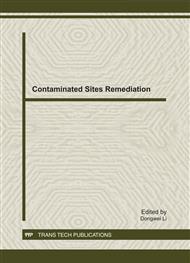p.238
p.244
p.250
p.254
p.262
p.268
p.273
p.280
p.284
Study on Potential Ecological Risk Assessment of Sediment from the Yangtze River (Chongqing Downtown Section) in China
Abstract:
The potential ecological risk index,proposed by Hakanson, was employed for evaluating the heavy metal contamination of the Yangtze River sediment in Chongqing downtown section. Basing on the analysis of last fifteen years monitored data from two national monitoring sections, the results indicated that: The potential ecological risk of the Yangtze River Chongqing downtown section was classified as moderate. The sequence of potential ecological risk was Zn< Pb (As) < As (Pb) < Cu < Cd< Hg, while the concentration of heavy metal in the sediment was Zn> Cu >Pb> As > Cd > Hg. The concentrations of Cd and Cu had significant correlation, Hg should be taken into prior consideration for pollution control and reduction due to its highest potential ecological risk. The RI in 2005 was highest, Hg contributed the most. All the heavy metal except for Pb had distinctive variance, but the variance of RI was not significant annually, It might carried the connotation of little difference on Pb emission amount. According to the location of monitoring site factor variance analysis, it implied that only the potential ecological risk of As and Cd varied significantly.
Info:
Periodical:
Pages:
262-267
Citation:
Online since:
December 2011
Authors:
Price:
Сopyright:
© 2012 Trans Tech Publications Ltd. All Rights Reserved
Share:
Citation:


